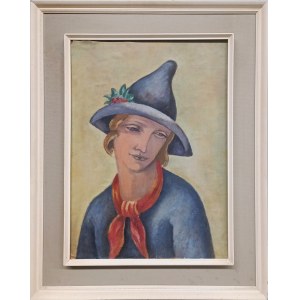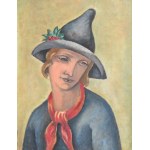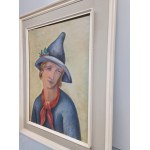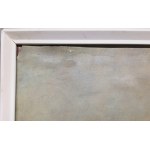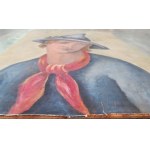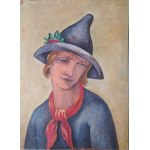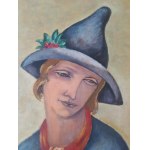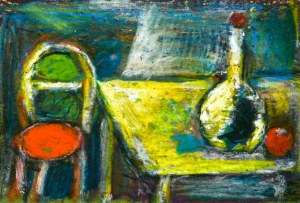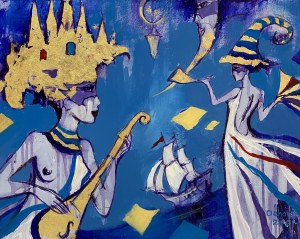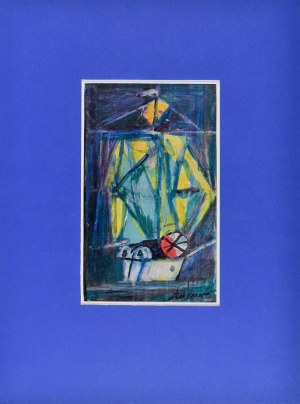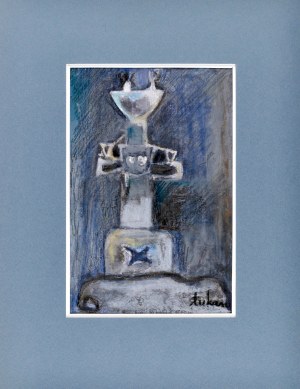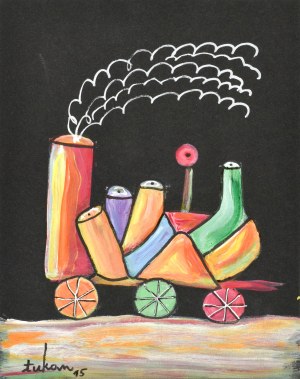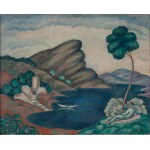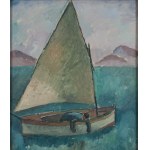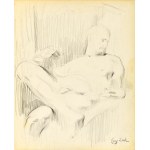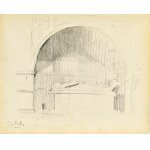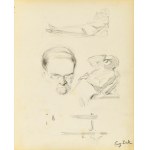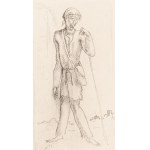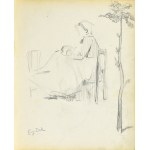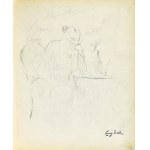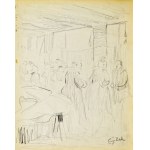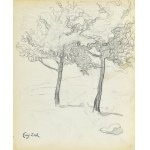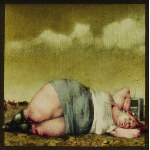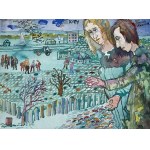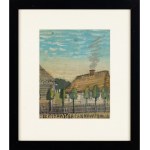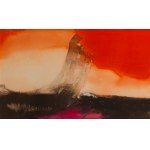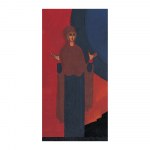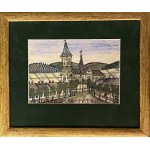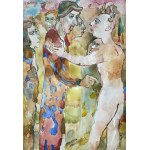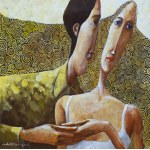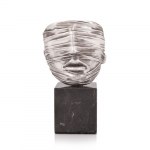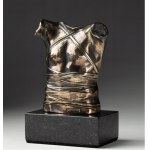Eugeniusz Zak (1884-1926), Head of a woman, ca. 1925.
Oil on paper pasted on dicta, 74 x 59 cm (frame) / 54.4 x 39.2 cm (inside passe partout).
Paper slightly peeled / damaged at edges in some places.
Comes from the collection of Lucie and Clément Pech*.
*
Eugene Zak, Head of a Woman (study), 1924
Oil on paper on dicot, 55 x 40 cm
Clément Pech, born June 28, 1882, was a French military officer and entrepreneur. He began his career in the army in 1902 and served until 1928. He was stationed in Czestochowa from 1918 to 1923, as part of a settlement between the newly formed Polish government and its French counterpart. Under it, French officers assisted in the establishment of Polish military structures, in return for which they received promotions. Clément Pech, then in the rank of lieutenant, was stationed in Częstochowa. He even received the Cross of Valor from the Polish government (a photo of the ID card entitling him to wear the decoration is in the documentation accompanying the painting). In Czestochowa he met Lucia (later in France she used a Frenchized version of the name "Lucie") Henig, who came from a well-to-do Jewish family. The couple married and in 1923. Lucie and Clément moved to France and settled in Saint-Mandé, a wealthy sub-Paris town.
Back in France, Lucie and Clément became friends with many artists. Clément was an artist himself and exhibited his work many times at the Paris Salons. Lucie, on the other hand, was not only characterized by great artistic sensitivity, but her knowledge of Polish, Russian, Ukrainian and even Lithuanian was also a great asset. As a result, she easily established contacts with many École de Paris artists who came from Eastern Europe and often spoke French poorly. So Lucie helped them with administrative matters, translated documents and correspondence, and returned small favors, among other things. According to the story of Frédéric Pech (grandson of Lucie and Clément), his father André (son of the couple) often recalled that his mother used to visit Montparnassie regularly, especially at the famous Le Dome restaurant, where the cream of international artists active in Paris at the time would gather.
One of the artists who was among Lucie's circle of acquaintances and friends was Eugene Zak (1). In the summer of 1924, Madame Pech, who was in Poland at the time, agreed to help the artist bring his nephew for the vacations, and later drive him back to Poland, so that he would be in time for the school year (2). It was then, as a token of gratitude, that Zak gave her a study for a painting he was working on at the time.
The work has remained in the Pech family until the present day: for many years it hung in the study of André, son of Lucie and Clément.
André Pech was an engineer who worked for many years for Clarel, a fiberboard company, as insulation for public lighting prototype projects. According to the memoirs of André's son, Frédéric, "Around 1960-61, my father decided to frame the painting, so he glued this oil on paper onto fiberboard, specially cut to size at the factory. He constructed the frame himself. I was a "do-it-yourself teenager" at the time, and I recall holding the pressure box (made of wood) while my father cut the strip with a handsaw. (...) Later, he painted the frame at the factory, placed the artwork in it, and to finish the frame, he used "Clarel adhesive paper" still present on the back of the work today. Since then, I have always seen this oil on paper, framed, hanging on the wall of his room, above his bed" (3).
After his death in 1962, the work was inherited by his son Frédéric, grandson Lucie and Clément. After the painting was donated to the Roi Doré Gallery and then ArtKrak Auction House, the frame was removed (to check the exact size, condition of the work and for aesthetic reasons).
Head of a Woman depicts a portrait of an anonymous woman, shot from a semi-profile (while the visible part of her torso appears to be positioned almost en face, her head is tilted in a gesture characteristic of Zak's figure). The final version of the work - an oil on canvas measuring 45 x 37.5 cm - is in the National Museum in Wroclaw. The two works are slightly differently framed: in the painting on canvas, the figure is more centrally positioned, cropped at the bottom (part of the handkerchief around the woman's neck is invisible), and the tip of her hat is close to the top edge of the canvas. The painting is also signed. The study under review, on the other hand, is an oil on paper, in which the depicted figure is shifted slightly to the left, the handkerchief around her neck is almost entirely visible, and the gap between the hat and the upper edge of the painting is slightly larger. The figure itself is a little stronger, but the larger space around it compensates for this impression, making the composition nevertheless light and "airy," which is further enhanced by the presence of numerous slightly curved lines. In the end, however, the study is very close to the final version - since it is an oil work with dimensions similar to a painting on canvas one can undoubtedly consider it the final stage of preparation for the creation of the final version, immediately preceding it. This is all the more evident since the painterly quality of the work is excellent, Zak here does not use additional simplifications or schematic treatment of the subject sometimes characteristic of preparatory works. The only differences - aside from the minor compositional changes cited above - are the lack of a signature and the somewhat less subtle use of color in the preparatory work. In the final version, the figure is slightly "softer," depicted with more finesse. Zak also uses slightly more contrasting colors, achieving, especially in the case of the handkerchief around the woman's neck, a chiaroscuro effect reminiscent of the play of light on silk, for example.
Thus, the study is an interesting work both from a historical point of view - it comes from an interesting, well-documented collection and is part of Zak's own history, his relationship with the interesting, though almost unknown figure that was Lucie Pech - and from an artistic point of view. For it is a study for one of Zak's most characteristic paintings from the 1920s, when the artist created works that often feature slightly elongated figures, frozen in characteristic theatrical poses, often wearing specific headgear. Simplified, somewhat geometrized forms suggest the influence of Cézanne, the somewhat melancholic character brings to mind the works of Puvis de Chavannes. At the same time, regardless of the assimilated, more or less obvious influences, Zak has created his own very distinctive style, full of lyricism and somewhat nostalgic poetry. Head of a Woman is thus a work typical of the last years of Zak's life, and thus an object of great historical, artistic and collector value.
(1) In his case, the language problem fell away, as Zak spoke fluent French. Nevertheless, they rotated in the same company, and both were also eager to keep in touch with the country. Moreover, Zak's wife, Jadwiga Kohn, came from Czestochowa, Lucie's hometown, which must have further brought the two couples together. There is even a possibility that the Zak family and the Pechs met while still in Poland. Although no material evidence makes it possible at the moment to specify when and under what circumstances the meeting took place - still in Poland or already in France - nevertheless Zak and his wife left France after the outbreak of World War I and settled in Częstochowa, where they stayed until around 1921. Clément Pech stayed in Czestochowa at exactly the same time, and that's when he met Lucia. Thus, there is a real possibility that Zak, being very close to France, established contacts with the French officer, especially interested in art, and with his fiancée and later wife, especially since they all turned in similar social circles.
(2) The story is passed down in the Pech family in the form of oral histories, but the family archives also contain documents confirming the artist's intimacy with Lucie, in particular a letter addressed "Dear Mrs. Lucie," dated May 29, 1924, in which Zak asks a friend... to bring his nephew on vacation.



